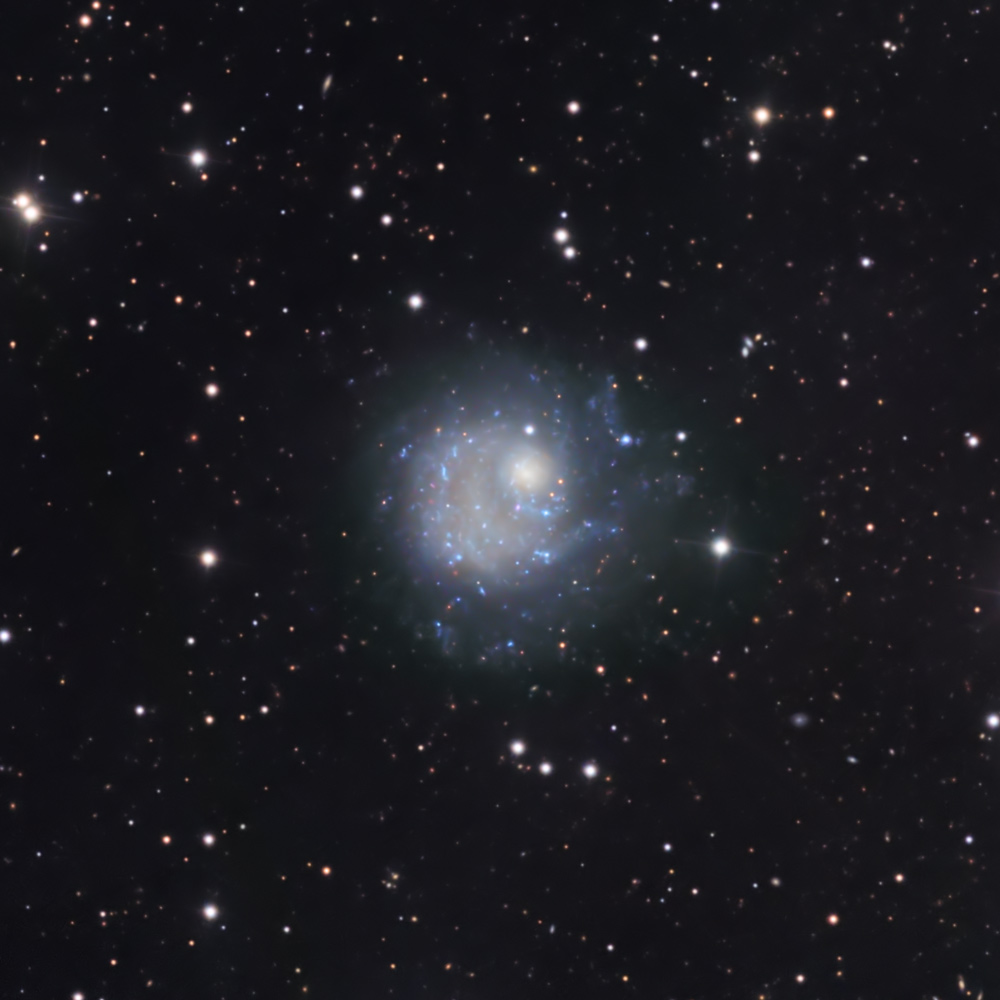

NGC 5474 is a dwarf galaxy very near to M101, a much
larger spiral galaxy. M101 and this little galaxy are both significantly deformed; a recently-published scholarly paper theorizes that, about 200 million years ago, NGC 5474 grazed M101 (passed within 45,000
light years of M101), resulting in the deformations we see in both galaxies. Technical Information: L:R:G:B: 860:195:195:240 (a total of almost 25 hours of light-frame exposure time); luminance was a blend of 20-minute images and 5-minute images; red and green exposures were all 15-minute exposures;
blue all 20-minute exposures. The luminance layer consisted of 37 twenty-minute images through the luminance filter and 24 five-minute images. The red channel is a combination of thirteen 15-minute images thorugh a red filter.
The green channel is a combination of thirteen 15-minute images through the green filter. The blue channel is a combination of twelve 20-minute images through a blue filter. Equipment: RC Optical Systems 14.5 inch Ritchey-Chretien carbon fiber truss telescope, with ion-milled optics and RCOS field flattener, at about f/9, and an SBIG STX-16803 camera with
internal filter wheel (SBIG filter set), guided by an SBIG AO-X, all riding on a Bisque Paramount ME German Equatorial Mount. Image Acquisition/Camera Control: Maxim DL, controlled with ACP Expert/Scheduler, working in concert with TheSky X. Processing: All images calibrated (darks, bias and sky flats), aligned, combined and cropped in Pixinsight. Color combine in Pixinsight. Some finish work (background neutralization,
color calibration, NoiseXTerminator and BlurXTerminator) done in Pixinsight; some cleanup finish work was done in Photoshop CC. Location: Data acquired remotely from Sierra Remote Observatories, Auberry, California, USA. Date: Images taken on many nights in June and July of 2022. Image posted September 9, 2022. Date: Image scale of full-resolution image: 0.56 arcseconds per pixel. Seeing: Generally good; luminance images varied in FWHM from 1.6 to 2.5 arcseconds. CCD Chip temperature: -25C Copyright 2022
Mark de Regt
It is sometimes called a "dwarf spiral galaxy," since it is a dwarf galaxy and still has some spiral structure. It's relatively close to us (about 21 million light years), and only about 300,000 light years from M101.
It is about 20,000 light years across, much smaller than both M101 and our Milky Way.
As is often the case with large-field deep-sky photographs, there are a lot of tiny (meaning, of course, very far away) galaxies in the background of this photo (including and especially what
appears to be a distant and large galaxy group midway between the left edge of the galaxy and the left edge of the frame).